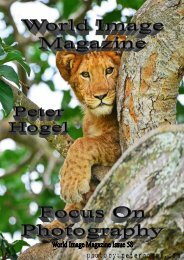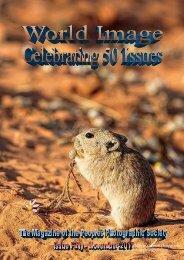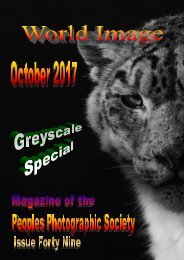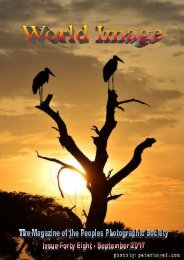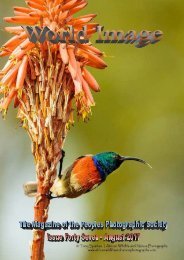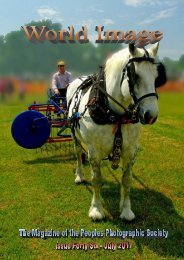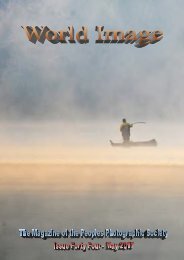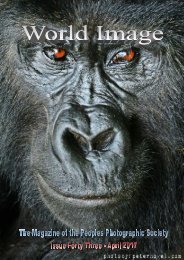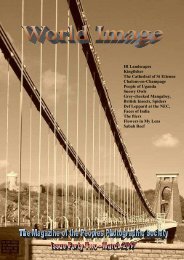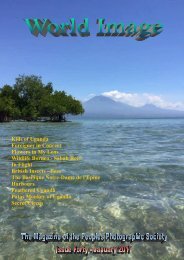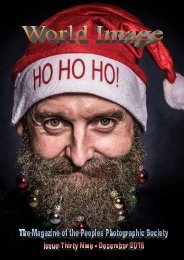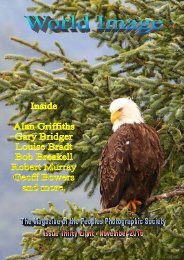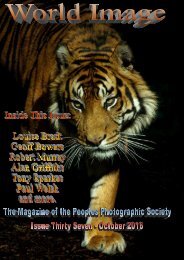World Image Issue 45 June 2017
The World Image Issue 45 for June 2017, the magazine of the Peoples Photographic Society
The World Image Issue 45 for June 2017, the magazine of the Peoples Photographic Society
You also want an ePaper? Increase the reach of your titles
YUMPU automatically turns print PDFs into web optimized ePapers that Google loves.
Website = photosociety.net Page 1 email = magazine@photosociety.net
National and Regional Management<br />
Gordon Longmead - England - CEO<br />
Peter Hogel - Uganda - Deputy CEO<br />
Scott Hurd - Namibia<br />
Tom Coetzee - South Africa<br />
Paul Welch—Australia<br />
Steve Cook - USA<br />
Robert Murray - Scotland<br />
Tina Andreasson - Sweden and Mexico<br />
Jack Glisson - Kentucky USA<br />
Rodger Lee - Steam Punk Events<br />
Contents:<br />
3 Wildlife of America - ‘Flying In’ by Larry Hitchins<br />
4 The Supermarine Spitfire pictures by Kevin W. Moore<br />
6 The Messerschmitt 108 & 109 pictures by Kevin W. Moore<br />
8 People of Uganda by Gordon Longmead<br />
12 Natural Light Portraiture- Paul Welch, Australia<br />
18 Langford Lowfields RSPB Site - Geoff Bowers<br />
20 Kazinga channel and hot air ballooning … Peter Hogel<br />
26 Pixel Count. How important is it? - Geoff Bowers<br />
28 Wildlife of Tanzania - Lions at the Kill by Paul Nanyaro<br />
29 Vervet Monkeys - Peter Hogel<br />
30 Flowers in My Garden - Gordon Longmead<br />
34 Candid New Orleans pictures by Louise Bradt<br />
36 A <strong>World</strong> of Abstractions by Gordon Longmead<br />
40 A Study in Nature - Bluetit - Pictures by Scott Latham<br />
41 A Study in Greyscale - Landscapes - Pictures by Alan Griffiths<br />
42 "Hey Dad, I Found a Shell On The Beach"<br />
43 Wildlife of America - Woodpeckers by Larry Hitchens<br />
<strong>World</strong> <strong>Image</strong> Magazine on Fine Art America<br />
Peoples Photographic Society Member galleries<br />
http://gordon-longmead.artistwebsites.com/index.html?tab=galleries<br />
As part of the expansion and ongoing development of the <strong>World</strong><br />
<strong>Image</strong> Magazine, we have established a website presence within Fine<br />
Art America for the presentation and promotion, and sale of member<br />
images.<br />
Members wishing to add their own gallery should contact Gordon@worldimagemag.co.uk for<br />
details.<br />
© Please remember that all articles and images published in this magazine are copyright protected<br />
Cover picture - He is coming by Kevin W Moore<br />
Website = photosociety.net Page 2 email = magazine@photosociety.net
A Study in Nature<br />
Wildlife of America - ‘Flying In’ by Larry Hitchins<br />
Mallard Male<br />
Mallard Female<br />
American Oystercatcher in Flight<br />
Black Skimmer<br />
Website = photosociety.net Page 3 email = magazine@photosociety.net
There were two planes that stirr<br />
but only the Spitfire became the<br />
The Spitfire was designed as<br />
interceptor aircraft by R. J. Mitch<br />
Aviation.<br />
During the Battle of Britain,<br />
Spitfire was seen by the public t<br />
the more numerous Hawker<br />
proportion of the burden against<br />
Spitfire units had a higher victo<br />
Hurricanes because of its higher<br />
In <strong>June</strong> 1940 Britain stood alone against the might of the German armed forces.<br />
At that moment in time any military commander or historian would have said<br />
that Britain would have fallen if attacked.<br />
The German strategy was a simple one, defeat the Royal Air Force, then invade<br />
and defeat the country as they had defeated every other country in Europe. The<br />
British officially recognise its duration as from 10 July until 31 October 1940 ,<br />
but this was only one part of a major battle for survival.<br />
During the Battle the Spitfires<br />
Luftwaffe fighters, mainly the<br />
aircraft which were a close matc<br />
of Britain, the Spitfire supersed<br />
backbone of RAF Fighter Comm<br />
Of the 2,936 aircrew who fough<br />
their lives and of the remainder<br />
of the War.<br />
The Battle of Britain Monume<br />
London, records the names of t<br />
who flew for Britain in the Battle<br />
Website = photosociety.net Page 4 email = magazine@photosociety.net
-range, high-performance<br />
-to-loss ratio than those flying<br />
In the present day we still have an affinity for the Spitfire and the Hurricane.<br />
The sight and sound of the aircraft flying overhead still conjures up images of<br />
the heroes of our youth (well for those of us who grew up with the battle<br />
comics).<br />
In our modern society our children have new heroes and new wonders of<br />
technology to admire, but none will ever replace the love affair we have with<br />
the Spitfire.<br />
Our thanks to Kevin W. Moore for this selection of images taken at Duxford<br />
in 2015.<br />
Website = photosociety.net Page 5 email = magazine@photosociety.net
Developed in the mid 1930’s<br />
service with the Luftwaffe in spr<br />
By the time of the Battle of Br<br />
Command had one major advan<br />
fuel injection system that allo<br />
conditions of negative-g.<br />
This meant that a pilot could div<br />
opponents could do and escape<br />
major disadvantage.<br />
The 109 had a restricted range an<br />
over Britain protecting their bo<br />
Messerschmitt 109 in tight formation<br />
Messe<br />
Spitfires and Hurricanes could la<br />
for the 109.<br />
Some variants of the 109 had a<br />
nose cone, but most 109’s were<br />
and two machine guns mounted<br />
through the propeller arc.<br />
The Messerschmitt 108 was dev<br />
record-breaking sports aircraft, a<br />
German pilots in preparation for<br />
Messerschmitt 109<br />
The 108 was the basis for the M<br />
the Supermarine Spitfire during t<br />
Pictures taken at Duxford in 201<br />
Website = photosociety.net Page 6 email = magazine@photosociety.net
Messerschmitt 108 with a 109 zipping past her<br />
-fuel, this was not an option<br />
-mounted cannon<br />
Messerschmitt 108<br />
Website = photosociety.net Page 7 email = magazine@photosociety.net
Website = photosociety.net Page 8 email = magazine@photosociety.net
Website = photosociety.net Page 9 email = magazine@photosociety.net
Website = photosociety.net Page 10 email = magazine@photosociety.net
Website = photosociety.net Page 11 email = magazine@photosociety.net
A lot of photographers like to do lighting and set ups with lights and backdrops of all kinds of shapes and<br />
sizes, but I find there is nothing better than setting your shots up in natural light, giving you the kinds of<br />
lighting you want. Nature provides the very best backdrops when you blur them with a lowered depth of<br />
field.<br />
I organized an interview and portrait shoot with a very special lady who has an amazing talent. Now before<br />
I go into detail, I will first let you know a few things I have found with portrait photography.<br />
I work in quite a un-orthodox way with a lot of my photography, especially when it comes to people.<br />
Through the years of photography, I can tell you that having your subjects relax is most important. Take<br />
your time and make them comfortable!!<br />
The lovely lady I did a shoot with is a renowned and very popular and amazing artist named Wendy Binks.<br />
Wendy who is highly respected in Western Australia with her bright and beautiful art of some pretty crazy<br />
characters for about 35 years and is still going strong.<br />
The main character that has given her a nick name as “The Emu Lady” is of course some outstanding<br />
Pottery, paintings, cups and kids’ Books of … yes you got it, Emu’s. Her Emu’s aren’t just your average<br />
emu though and you can see her work on line all over the world, http://wendybinks.com.au/ . You can even<br />
order your pictures, books etc. signed by Wendy too.<br />
I couldn’t help myself; I had to pick Wendy’s brain on a few things about her success as a self-publisher as<br />
well as an artist. This of course was a great way to settle in and let Wendy know the way I would be doing<br />
the shoot and help her to relax with a nice cup of tea.<br />
I find with most people they hate getting their picture taken and doing the whole robot style shoot with<br />
lights and backdrops and expensive equipment, it all usually ends up with the same result with each person,<br />
a grimmis rather than a natural smile.<br />
The start of backdrops for us…<br />
Now going back a bit my wife and I recently moved to a new place and the house we picked out has some<br />
great little spots through and around it to get natural lighting and enables you to get some great shots of<br />
people in portraits along with natural backdrops… Just how I like it… El Naturel.<br />
Working things in your favour is important with portraits but working with the light you have and setting up<br />
the camera is most important to turn out some great portraits as natural as possible. Don’t forget you are an<br />
artist too, and YOUR paint brush is a camera. Your imagination is the tool.<br />
I thoroughly enjoyed doing the shoot with Wendy, I asked a few questions and wrote some info down<br />
before settling into doing some shots. Once Wendy had talked about the things she is passionate about,<br />
which was a whole lot more than just art. We were good to get into doing some nice shots, relaxed and in<br />
the right frame of mind.<br />
Website = photosociety.net Page 12 email = magazine@photosociety.net
The first spot I had picked was the back veranda which has some shade cloth across the whole area so any<br />
bright light was filtered making it nice, flat and just right for some wonderful front on shots. It really didn’t<br />
matter which way Wendy faced, the light was beautiful. The backdrop was the wood at the end of the<br />
veranda which has some awesome markings and was perfect to set the scene I wanted to show off Wendy<br />
and her fantastic art.<br />
This kind of backdrop with browns and beige was perfect to compliment the brightly coloured paintings and<br />
books as well as Wendy being bright and blonde too.<br />
I particularly liked the shark portrait which not only with the background being simple yet different, it<br />
bought some real warmth to the shot overall.<br />
I had to have a play with these shots and it turned out that the shark shot is really nice in black and white<br />
too. Don’t be afraid to experiment with portrait shots. Some people suite black and white… but be aware,<br />
some don’t.<br />
As artists we can see differently to others and can pick out the pictures that work in black and white. I loved<br />
the way Wendy had painted the shark and how when it was put in black and white, the white on the shark<br />
stood out and really made the picture pop.<br />
I could have gone further with it but this was poppin enough for me… I see many photographers over<br />
saturate or do way too much to pictures which I think spoils what you actually see. I say keep it as real as<br />
possible… especially with Portraits.<br />
Wendy was a true sport with this shoot and besides our conversation with Painting I found out through the<br />
shoot that Wendy has a part in helping the WA museum and a part in the help for the endangered Ground<br />
Parrot, an endemic bird to Western Australia and the numbat also endangered.<br />
So besides the art, books, mugs etc. etc. Wendy is as passionate as my wife and I with wildlife.<br />
But of course I should have known that anyway, as Wendy’s art is wildlife.<br />
Website = photosociety.net Page 13 email = magazine@photosociety.net
Website = photosociety.net Page 14 email = magazine@photosociety.net
When Wendy told me she liked snakes and lizards I<br />
figured this would be a great opportunity to<br />
introduce her to Rango our pet bearded dragon. So<br />
with this in mind I had to do some shots with the<br />
light from behind.<br />
This was a good chance to show how no matter<br />
where your light comes from, you can work with it.<br />
I had some nice shots from the light behind, like this<br />
one of Wendy with one of her emu tea cups.<br />
Not too much light but enough for a nice profile<br />
shot that had a sense of cosy about it. I used defused<br />
light with a nice warm backdrop, once again beige<br />
and brown colours.<br />
This was just in our living room. If you want to<br />
have more light on the face, you still don’t have to<br />
have lights, just a reflector will do the job. I didn’t<br />
use mine so that I could show the low light profile<br />
can work well, besides… I liked the lighting as it is<br />
here.<br />
Notice the tea cup is also Wendy’s work.<br />
While in this room I took the light to a new level and<br />
adjusted the camera slightly with a faster shutter speed<br />
so that I let less light in. This created a cool black and<br />
white profile shot with a dark side. Not that Wendy has<br />
a dark side, but this was a shot I had to try.<br />
For the style of shot I was after it worked out well. All<br />
I did was adjust the shutter speed from 1/200 sec to<br />
1/160 sec so you can see how much a slight adjustment<br />
can make with low light situations.<br />
As the time went on Wendy talked about her property<br />
in the south of Western Australia where she is doing a<br />
fairly large project in her studio. Dwelingup is a lovely<br />
little town with about 4-500 people populating it.<br />
I have only been there once or twice but it’s a beautiful<br />
spot to be around nature for those wanting to shoot<br />
things… oops, Photograph things.<br />
Once we had done with the living room it was time to<br />
go outside where the trees made a beautiful natural<br />
backdrop for the remainder of shots I took.<br />
Website = photosociety.net Page 15 email = magazine@photosociety.net
I can’t point out enough how important a good backdrop is during a portrait shoot. I have a couple of lovely<br />
trees growing in the front yard to have as back drops and one of which I found would be totally appropriate<br />
for Wendy and her Art being a nice gum tree… very Australian and perfect for this shoot.<br />
With the sun high in the sky it was<br />
hard not to have the squinty look, so<br />
having Wendy laugh was the trick.<br />
Quite unintentionally I got spiked by a<br />
palm tree in the butt cheek but this<br />
enabled me to capture the funny<br />
moment with a nice giggle from<br />
Wendy.<br />
The final shots were with another tree<br />
and showing her very popular emu<br />
painting Wendy finished the shoot<br />
with style.<br />
An added bonus from Mother Nature was a slight breeze and with a nice shadow in place to stop the squinty<br />
look, I got several more shots.<br />
During the shoot the continued conversation<br />
revealed Wendy did more to add to her talents.<br />
Wendy does workshops for people who want to<br />
publish their own books, (this I will have to look<br />
into more I think) at just $110 per session.<br />
I think it would be well worth the knowledge to do<br />
something like that. I know from personal<br />
experience that writing books is one thing, getting<br />
them published is totally another.<br />
I am working on a couple of books on differing<br />
subjects but of course one of them is Photographic.<br />
At the end of the shoot it’s always nice to continue<br />
conversation for a bit and make sure you explain to<br />
the customer the steps to follow and when and how<br />
they will receive the shots.<br />
A shoot like this should only take an hour or two. To<br />
sort out the shots and edit them will take at least two<br />
to three hours making sure the camera settings are<br />
sorted from the start, checking and changing as you<br />
go.<br />
Many photographers I have heard about that rush<br />
things end up spending more time in the editing<br />
suite than needed.<br />
So a very simple thing to do is RELAX take your time and get it right the first time.<br />
Website = photosociety.net Page 16 email = magazine@photosociety.net
Now just to recap a touch, this shoot cost nothing but a bit of time. The model (Wendy Binks) was great, the<br />
lighting and backdrops were natural, the mood was relaxed and friendly and all in all the shoot went<br />
smoothly.<br />
The next shoot you do whether it has to be in a studio or in the open.<br />
Make the person comfortable.<br />
Explain some of the shoot to them before, during and after.<br />
Don’t rush the shoots this only makes people stiffen up.<br />
There were no robotic stances, no grimmises and the end result… well you can see for yourself.<br />
If you would like to see more of Wendy Binks art, just check it out on the link in this article… You won’t<br />
be disappointed and your kids will love it too.<br />
Website = photosociety.net Page 17 email = magazine@photosociety.net
Langford Lowfields resides in a working quarry on<br />
the banks of the River Trent, Nottinghamshire,<br />
England, which has been created by bulldozers and<br />
excavators in partnership with Lafarge Tarmac,<br />
who own the land. The site currently covers about<br />
180 acres and will continue to be developed. Once<br />
the quarrying operations are finished, the site will<br />
provide about 247 acres of reedbed which will be<br />
the largest such area in the East Midlands.<br />
Website = photosociety.net Page 18 email = magazine@photosociety.net
Website = photosociety.net Page 19 email = magazine@photosociety.net
Hot air balloon is a truly amazing way to see the<br />
scenery, and if you are lucky, wildlife from above.<br />
The car with the balloon pulls over and they roll out<br />
the balloon and position the basket, after filling the<br />
balloon with air, heating it up with the burner we all<br />
jump in to the basket, and take of.<br />
We start up early…early in the morning to head out<br />
to the starting point, it still dark while we pass the<br />
lioness with her cubs, a few minutes later we stop.<br />
Website = photosociety.net Page 20 email = magazine@photosociety.net
The heat from the burner hits you and the noise is loud but just a few seconds later we have reached heights<br />
and the burner goes quiet it is amazingly tranquil, as we see the sun rise over QE, and the scenery is<br />
stunning.<br />
Website = photosociety.net Page 21 email = magazine@photosociety.net
After about one hour of “breathtaking” we land and<br />
sit down for our luxury breakfast in the bush, with<br />
elephants on a safe distance we can peacefully enjoy<br />
the whole continental luxury.<br />
On the boat, with proper refreshments, in shade and<br />
with a soothing breeze we quietly cruise along the<br />
channel, comfortably sitting, watching the wildlife<br />
of Uganda pass us un the shore, hippos yawning<br />
each other to say I'm bigger than you, back off<br />
After the early morning adventures and a day in the<br />
park we head down for the boat…we are cruising<br />
Kazinga channel, to me its probably the best way to<br />
see the wildlife and you really haven’t done QE<br />
without the channel.<br />
Elephants coming to drink, we are so close but still<br />
they don’t seem disturbed by our presence …a heard<br />
of buffaloes are rolling in the mud, cooling of and in<br />
the shadows the crocodile is watching.<br />
Website = photosociety.net Page 22 email = magazine@photosociety.net
The African Water Buffalo , otherwise known as the Widow Maker and the Black Death<br />
Website = photosociety.net Page 23 email = magazine@photosociety.net
And there are so many birds, even if you didn’t<br />
think you were interested in birds.<br />
You cant help to be amazed by their colours shapes<br />
and sizes, from the tiny ones to the mighty fish eagle<br />
Website = photosociety.net Page 24 email = magazine@photosociety.net
Tomorrow we will go back to Kampala, to plan our<br />
next adventure…<br />
Peter Hogel<br />
Website = photosociety.net Page 25 email = magazine@photosociety.net
So many of us are obsessed with the pixel count of new<br />
cameras and always want more. I had a look back at what I<br />
took back in 2004 and 5 recently and was surprised at the<br />
picture quality.<br />
I started my Olympus journey in 2004 with a small 5 mega<br />
pixel compact with a viewfinder and a 5 times zoom. It had<br />
no manual controls but several good scene modes and a<br />
panorama stitch function.<br />
My previous cameras had always been basic film ones<br />
from Box Brownie to APS and I was not so interested in<br />
photography back then. I mainly used a video camera to<br />
record holiday stuff, not liking the wait for film to be<br />
developed.<br />
Gradually I became more interested and moved up in<br />
2008 to an Olympus E410 DSLR. This had 10 Mega<br />
Pixels and I thought “wow now I've arrived”. This<br />
brought a new learning curve and I forgot about my point<br />
and shoot down there at 5 mega pixels.<br />
Here are some examples of the older pictures. I’m now<br />
quite proud of them and they print very well at A3+ so to<br />
me the lesson is, as so often, it’s not the quantity but the<br />
quality that counts.<br />
Website = photosociety.net Page 26 email = magazine@photosociety.net
Interesting question this one, and the answer is<br />
actually quite easy. For the professional<br />
photographer he must produce the best possible<br />
quality of image for their customer. The more pixels<br />
the more defined will be the final image enabling it<br />
to be enlarged to a much greater size without losing<br />
quality. It also gives a sharper image at the smaller<br />
sizes such as A4.<br />
Most modern cameras, regardless of the number of<br />
pixels per inch, will produce excellent quality up to<br />
monitor size. Ed.<br />
Website = photosociety.net Page 27 email = magazine@photosociety.net
Website = photosociety.net Page 28 email = magazine@photosociety.net
Vervet monkeys, Frequent safari goers would probably say “but they are everywhere” and matter the fact<br />
they are, Vervets are most likely THE most numerous monkey in the world, besides humans (scary music<br />
playing) yes we are primates as well…There are 21 species of Vervets described, Troops of 140<br />
individuals (wait, hold, that was 1,2,3,4, wait 1,2,3…) have been registered, but normally they hang out in<br />
troops of 40-60 of their closest relatives….<br />
Website = photosociety.net Page 29 email = magazine@photosociety.net
Website = photosociety.net Page 30 email = magazine@photosociety.net
Website = photosociety.net Page 31 email = magazine@photosociety.net
Website = photosociety.net Page 32 email = magazine@photosociety.net
Website = photosociety.net Page 33 email = magazine@photosociety.net
A street vendor on Bourbon Street - selling poetry.<br />
Delivery time on one of the streets around Jackson<br />
Square<br />
The bar in The Court of Two Sisters, which is a must see venue if<br />
View from hotel balcony<br />
Orleans. It has a beautiful open courtyard and they have a wonderfu<br />
Looking down Iberville towards Royal St.<br />
running buffet and you can sit and eat and enjoy the jazz band that<br />
Website = photosociety.net Page 34 pleasure. Aemail wonderful = magazine@photosociety.net<br />
place and experience.
One of the many Bourbon Street Bars<br />
View from the St. Charles Street Car,<br />
looking down Canal<br />
Homeless lady wanders Bourbon Street<br />
clutching her bottle of whiskey. Her eyes<br />
were closed, but she never bumped into<br />
anyone or anything.<br />
Panning shot of a Streetcar on St. Charles in the Garden District<br />
with Rayne Memorial Church behind.<br />
Website = photosociety.net Page 35 email = magazine@photosociety.net
Website = photosociety.net Page 36 email = magazine@photosociety.net
Website = photosociety.net Page 37 email = magazine@photosociety.net
Website = photosociety.net Page 38 email = magazine@photosociety.net
Website = photosociety.net Page 39 email = magazine@photosociety.net
Website = photosociety.net Page 40 email = magazine@photosociety.net
Website = photosociety.net Page 41 email = magazine@photosociety.net
I can not speak for those living outside of England, and perhaps it is<br />
just a coastal joke from the southern and eastern coast of this fair land,<br />
but I wonder how many of us are at that certain age when we can recall<br />
the true meaning of the statement?<br />
Although I have almost reached the age of 63, it was still floating<br />
around during my childhood and for some strange reason has stuck<br />
with me, recalled to mind every time I visit the coast.<br />
Of course the meaning has changed since the last war when<br />
finding a shell on the beach referred to the exploding kind and not<br />
the mussel shells we find today.<br />
When we visit the seaside it is<br />
almost guaranteed that the<br />
pictures we naturally take are<br />
the views.<br />
The beach / water / sky<br />
pictures being the prime subjects. We may even turn our attention to<br />
the nearby town or cliffs, but what about the beach? Is it just sand and<br />
stones?<br />
Stones on the beaches may<br />
not even originate there, so<br />
we end up with a large<br />
variety of stone from the<br />
granite and schist, to various agates and even amber.<br />
Driftwood can also be found on the beaches, but get up early as most<br />
is removed by the local councils who like nice clean beaches.<br />
Well this one is at Hunstanton in Norfolk, England, and yes it is<br />
mainly sand and stones. But as you look closer there are the<br />
reflections and shadows, closer still and the stones themselves<br />
display both form and colour. No two are alike, just like<br />
fingerprints.<br />
That jelly like mess we avoid may be the key to a small fortune if it really did come from a whale, and yet<br />
we turn up our noses at it. Not so the very expensive perfume that is made from it.<br />
There are other forms of life<br />
in the rock pools and even<br />
the seaweed on the stones<br />
and rocks, this one reminded<br />
me of the early, and very<br />
badly made, wigs, albeit well<br />
a well groomed stone.<br />
GL.<br />
Website = photosociety.net Page 42 email = magazine@photosociety.net
Red Bellied Woodpecker<br />
Yellow Shafted Flicker<br />
Pileated Woodpecker<br />
Red Bellied Woodpecker<br />
Website = photosociety.net Page 43 email = magazine@photosociety.net
Kuyimba means 'to sing' in the<br />
Zambian Chinyanja language and<br />
this site is a celebration of the sights<br />
and sounds of southern Africa. Join<br />
us to experience it for yourself.<br />
Derek & Sarah Solomon<br />
www.kuyimba.com<br />
Website = photosociety.net Page 44 email = magazine@photosociety.net
We hope you like the magazine, the size and content of future issues depends on you.<br />
Submissions for the next issue are being accepted<br />
Website = photosociety.net Page <strong>45</strong> email = magazine@photosociety.net
Website = photosociety.net Page 46 email = magazine@photosociety.net




